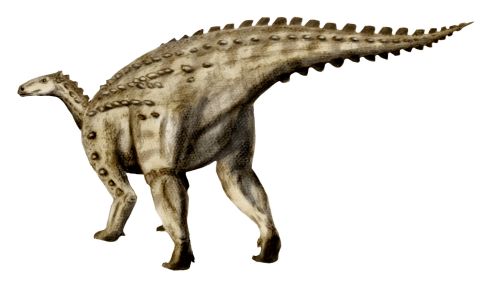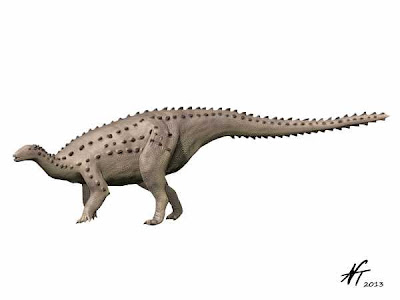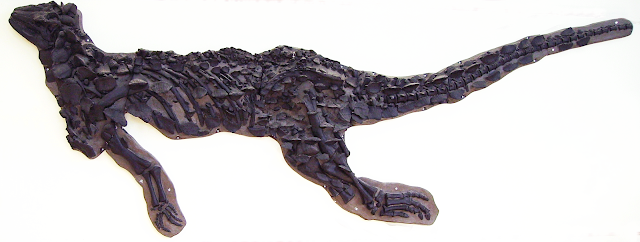Science for Kids has a pretty good fact page going for Zalmoxes. It is a bit short, but it gets the important information out there quick and in an easily readable way. Additionally, I found a pretty sweet puzzle site that is any age friendly. You can make the pieces any size you want from a 12x12 puzzle down to a 2x2 puzzle. That means you, or your child/nephew/niece/sibling, can customize the puzzle to fit yours, or their, skill abilities. Pretty nifty if you ask me. Seeing as how you can create your own puzzles on that site, be prepared for more Sunday kid friendly posts with dinosaur puzzles! This will help a lot for dinosaurs that are not as popular. Also, when you are done with your puzzles and reading your facts, here are a couple of coloring pages worth all kinds of time and fun to color and detail!
↧
Children and Dwarf Dinosaurs
↧
No One in Motion
Zalmoxes does not appear in motion pictures, short or full length, animated or computer graphics. There is an alphabet video that mentions Zalmoxes in the Z slot of the alphabet; there really are not too many dinosaur choices in the Z slots of the alphabet. Dinosaur Train's A to Z episode does not use Zalmoxes, sadly for us; I know everyone wants to see the Dinosaur Train song again and again. Zalmoxes, and the other Transylvanian island dinosaurs that have been discovered, truly do deserve their own documentary. Some day this will certainly happen. It has not so far and thus I have nothing to share in terms of video today, unfortunately.
↧
↧
Papers of the Zalmoxes
Zalmoxes, the poor unfortunate "unusual Euornithopod" has had some osteological and phylogenetic study done on it. That 2003 study by Weishampel, Jianu, Csiki, and Norman was the landmark paper that renamed Rhabdodon robustus as Zalmoxes robustus and identified a second species as Zalmoxes shqiperorum. Thankfully Dr. Weishampel is nice enough to host his own papers so we can read the entire paper, all 59 pages, of the in depth anatomical description of Zalmoxes and how it differs, and is thus officially distanced, from Rhabdodon. The matrices and characters are included, which is always nice to have, so that the systematists amongst us can really look at the characters that were analyzed. The osteology of newer specimens has also been discussed, this time only for Z. shqiperorum though. The 2009 paper discusses a new fossil site in Transylvania, Romania and the specimens of Z. shqiperorum that had been unearthed from that location.
↧
The Island Life
Depending on the specific species, the size of the Zalmoxes differs greatly. Z. shqiperorum was the largest species and could grow up to four and a half meters long. However, the smallest, Z. robustus, would only grow up to three meters long. Z. robustus was thought to be so much smaller than the Z. shqiperorum because of insular dwarfism. Insular dwarfism was the theory that large animals evolved by decreasing in size when the food sources are limited due to lack of land mass. Since Zalmoxes lived on islands, they were said to evolve over generations by decreasing in size so they would not need to eat as much plant matter. This allowed for Zalmoxes to continue to populate and also have lots of available food.
↧
What A Strange Little Dinosaur
Zalmoxes lacks a lot of popular culture references we have seen on the internet. It did feature in some news stories back when it was renamed and a little afterwards. Zalmoxes has warranted enough looks that it has been detailed by the Natural Museum of History in London on a fact page also. However, as we have seen, it did not manage to ascend to documentary dinosaur status as yet and has also not been portrayed as a model or toy dinosaur to my knowledge at this date. Zalmoxes has made its name in World of Warcraft as an item, as have many other dinosaurs. Apparently it is represented by a robe that players can acquire on a once previously mentioned landscape within the game. Sadly, that is where that popularity ends for Zalmoxes. A greater number of dwarfed dinosaurs from Transylvania are being discovered these days and that will pique interest in someone soon enough I am sure to warrant the creation of a documentary or toys or something else that gets the name out there more.
↧
↧
From Colorado to Portugal
 |
| ©Davide Bonadonna |
This week I have a monster of a dinosaur for us. Obviously, in sticking with my typical rotation, we are going to look at a predator this week, and not just any predator, but one that has been discovered in both Colorado and Portugal in varying stages of life including as an egg and is a fearsome predator of the late Jurassic. Larger than most of its contemporaries, including most Allosaurus individuals, Torvosaurus tanneri was a forced to be reckoned with. Three clawed hands and massive jaws were supported by a robust torso and well muscled and strong legs in this megalosaur. This "savage lizard" was between 30 and 26ft (9 and 11m) long and probably weighed nearly 2.2 tons (2 metric tons). The Portuguese specimen is the largest discovered meaning that the eastern counterparts of the Colorado specimens were either slightly larger overall or that the Colorado specimen may be a younger individual than the Portugal specimen. The Portuguese Torvosaurus rivals T. rex's skull and is much larger than any other Jurassic age predator while the Colorado material is slightly smaller than Allosaurus/Saurophaganax and another animal known as Edmarka (which may be synonymous with Torvosaurus).
↧
Key Features of Torvosaurus
 |
| The natural conclusion to yesterday's art by Davide Bonadonna |
| Skeleton at the North American Museum of Ancient Life (Thanksgiving Point, Lehi, UT), photo courtesy of user Ninjatacoshell |
↧
Torvosaurus Educates, Does Not Eat, Children
We know if Torvosaurus were alive today it would not differentiate between adults and children in its diet, but we can assume that today it will only educate children rather than eat them. Doing so are the nice webmasters of Educated Learning in both abbreviated and detailed fact pages, the well written blog of Brian Switek, and a page on Dinosaur Jungle. Additionally, there is a rather fun educational video from HooplaKidz TV, which we have used before here, that depicts an animated Torvosaurus describing herself and just generally being entertaining. In terms of actual coloring pages today, there are none for Torvosaurus; our first missing link, so to speak, of the day. There are quality images that would make good coloring sheets, but they are the property of their artists and are not meant for coloring, so if anyone out there wants to color them in they need to be sure to ask the permission of the artists before using their works.
↧
Torvosaurus on the Little Screen
Torvosaurus is one of those dinosaurs that was chosen to appear in the short series Dinosaur Revolution. The reviews on Dinosaur Revolution are mixed, but I feel that an educated mind can see both the fantasy of Hollywood as well as the science and take things with a grain of salt while doing their own research to double check the facts; though I know that the majority of the world does not double check facts of television shows and I am perhaps a little idealistic when it comes to assuming that people watching documentaries further research that which they see on television. As is sometimes done with television, the Torvosaurus and an Allosaurus in the episode are given immensely constructed and complex back stories, somewhat anthropomorphizing the dinosaurs. The Torvosaurus is portrayed as the more evil or bad of the two and sympathy is created for the Allosaurus and, in the way of many documentaries and shows with animals that are characterized in human ways, the "bad guy" ends up being run off or dies; like I stated before, there is a grain of salt approach to watching shows like this. Regardless, there are two relevant clips for today from the episode that show a model of Torvosaurus in action. The first is above and depicts the supposed battle between a Torvosaurus and an Allosaurus. The second is sort of a montage of Torvosaurus hunting sauropods called Dinheirosaurus.
↧
↧
Torvosaurus Gets Inked
 |
| ©Dmitry Bogdanov |
↧
Welcome to Wednesday
Nathan Eldon Tanner probably never expected to have a dinosaur named after him. He did, however, and it just happened to be one of the largest predators of the Jurassic that happens to have had material located on two continents. Torvosaurustanneri is a pretty interesting dinosaur for reasons other than its linked history via its name with the Church of Latter Day Saints. The Portuguese material attributed to Torvosaurus consists of a single tibia; that is some pretty distinctive bone matter to be able to be attributed to a species from another continent based entirely on that sole fragment of an entire living being. Colorado material is slightly more substantial, obviously, given that the animal was described and possesses enough characters to not only definitively differentiate from other North American Jurassic predators but also to warrant a proposal to elevate its status to that of a principal family. Torvosaurus was, as the flora and fauna discovered in and around the area in which Torvosaurus was discovered in Colorado, a predator that lived near rivers, wetlands, and an alkaline lake (Portuguese data of the habitat of Torvosaurus is not known in full at this time). All kinds of animals and plants were discovered in the Dry Mesa Quarry of Montrose County Colorado (along the border of Colorado and Utah). Studies of the channel flow velocity and deposition of bones in the dry Mesa Quarry have been done, but at the moment I do not have the data that shows where within the channel Torvosaurus material was discovered. It appears that predator remains are concentrated in the lower velocity areas of the channel flow, according to the study.
↧
The Saddest Day
| Taken from dinosaurjim.com, which was taken from elsewhere. If anyone knows the original illustrator please let me know. It may be based off of Scott Hartman's skeleton, but it is not the one he has posted on his site. |
↧
Slide on Over Scelidosaurus
 |
| ©Nobu Tamura |
↧
↧
Scelidiosaurs Slide Show
 |
| Nobu Tamura's updated Scelidosaurus |
 |
| Lyme Regis Museum, Dorset, England |
↧
Scelidosaurus May Confuse Younger Viewers
A reason that younger readers/viewers may get confused is that Scelidosaurus is a basal member of the group and therefore looks a bit like a stegosaur and a bit like an ankylosaur without being either. That said, there is no reason that the children of the world should not get acquainted with KidsDinos and Enchanted Learning. Additionally, they can color online or print out a copy of coloring pages on this site or the image shown below is also available.
 |
| Via Arthur's dinosaur clipart |
↧
Moving Scelidosaurs
Scelidosaurus is not in any documentaries nor does it have any great influence in cartoons or many other forms of media. It does appear in one game, an educational game known as Dinosaur Safari (see below), but it does not even figure as a main animal there. There are quite a few animals in the game though, so it is good enough that it made the cut. It may look a little shoddy, but it is a bit older, and as such that is actually a pretty good looking game overall and I will not complain.
↧
When You're This Old...
People have written about Scelidosaurus and they have also studied it a lot. The older the dinosaur the more it has been studied would be a nice rule of thumb, but we know that is not the case. Regardless, this dinosaur does pretty well follow that ideal for a variety of reasons including its position as one of the most basal members of its group. Being the first complete dinosaur discovered had its advantages, such as the wonderfully in depth description provided by Owen in his 1863 publication A Monograph of the Fossil Reptilia of the Liassic Formations, Parts 1-3. He starts the discussion by noting that the skeleton available to him is a young Scelidosaurus and not an adult; this constitutes a very important distinction when considering the life histories of specimens. Owen was also using a lot of jumbled material, however, and a little over 100 years later, in 1968, B.H. Newman wrote a paper describing the lectotype of Scelidosaurus, Lydekker 1888 (a right knee joint/complex), as a megalosaur and calling for a new lectotype to be raised. He proposed that the skull and associated skeleton be placed as the lectotype in the place of Lydekker's lectotype. Newer research and discoveries have been conducted as well. In 2003, for instance, soft tissue was discovered and publicized in a Scelidosaurus find. Not as new, but still of great importance to the study of Scelidosaurus is the discovery of Scelidosaurus remains in Arizona in 1989, making Scelidosaurus not only one of the earliest complete dinosaurs discovered, but also one of the many that have been found in what, even during its lifetime, was a great range of lands and habitats.
↧
↧
Completely Incomplete
 |
| Cast of the David Sole specimen. |
↧
Almost Complete
 |
| Photos by Adam Stuart Smith and Stefan Schröeder, top to bottom as seen on the Dinosaur Toy Blog |
↧
Coelurus in the Afternoon
 |
| ©Nobu Tamura |
↧



